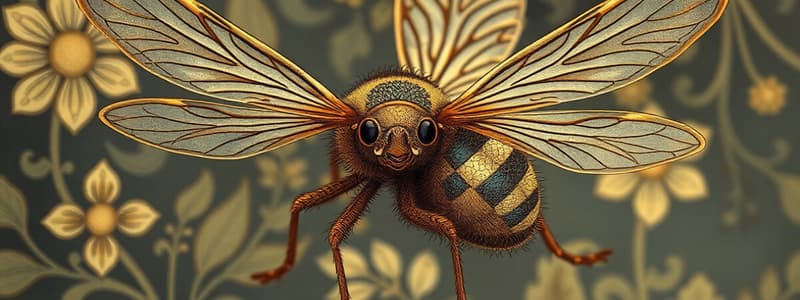Podcast
Questions and Answers
Which of the following ectoparasites are vectors for parasitic protozoa causing trypanosomiasis?
Which of the following ectoparasites are vectors for parasitic protozoa causing trypanosomiasis?
- Fleas
- Mites
- Tsetse flies (correct)
- Lice
All lice have wings.
All lice have wings.
False (B)
What is the lifecycle duration of lice?
What is the lifecycle duration of lice?
3-4 weeks
The female tsetse fly produces larvae that pupate on the ______.
The female tsetse fly produces larvae that pupate on the ______.
Which of the following is commonly known to cause fly strike in sheep?
Which of the following is commonly known to cause fly strike in sheep?
What type of mouthparts do lice possess?
What type of mouthparts do lice possess?
Match the following ectoparasites with their respective hosts:
Match the following ectoparasites with their respective hosts:
Mite cycles can span from 1 to 4 weeks.
Mite cycles can span from 1 to 4 weeks.
Myiasis is commonly associated with ______ flies.
Myiasis is commonly associated with ______ flies.
Which of the following measures is not necessary for treating demodex infestations?
Which of the following measures is not necessary for treating demodex infestations?
What type of metamorphism do fleas undergo?
What type of metamorphism do fleas undergo?
Ectoparasites like fleas and ticks are primarily blood suckers.
Ectoparasites like fleas and ticks are primarily blood suckers.
Which of the following is a common symptom of infestation by Sarcoptes mites?
Which of the following is a common symptom of infestation by Sarcoptes mites?
What are the primary clinical signs associated with a flea infestation?
What are the primary clinical signs associated with a flea infestation?
The main transmitted disease associated with bites from the black fly is _____ itch.
The main transmitted disease associated with bites from the black fly is _____ itch.
Trixacarus mites primarily affect guinea pigs.
Trixacarus mites primarily affect guinea pigs.
Match the ectoparasites with their characteristics:
Match the ectoparasites with their characteristics:
What is a common method of diagnosis for Sarcoptes mite infestation?
What is a common method of diagnosis for Sarcoptes mite infestation?
What is one control measure for managing ectoparasites?
What is one control measure for managing ectoparasites?
The life cycle of chiggers includes their larval stage, which is characterized by having ___ pairs of legs.
The life cycle of chiggers includes their larval stage, which is characterized by having ___ pairs of legs.
Fleas can transmit diseases like Bartonella henselae, which cause cat scratch disease.
Fleas can transmit diseases like Bartonella henselae, which cause cat scratch disease.
What type of ectoparasite is Demodex?
What type of ectoparasite is Demodex?
What is an example of a disease transmitted by mosquitoes?
What is an example of a disease transmitted by mosquitoes?
Notoedres affects cats predominantly on their body limbs.
Notoedres affects cats predominantly on their body limbs.
Hedgehog fleas are also known to affect _____.
Hedgehog fleas are also known to affect _____.
Name a burrowing mite that affects dogs.
Name a burrowing mite that affects dogs.
Which of the following is NOT a characteristic of the flea?
Which of the following is NOT a characteristic of the flea?
The ___ mite is known for causing scaly face and tassel foot in birds.
The ___ mite is known for causing scaly face and tassel foot in birds.
The lifecycle of simuliids involves only two stages.
The lifecycle of simuliids involves only two stages.
Match the mites with their respective hosts:
Match the mites with their respective hosts:
What control measure is effective for managing ectoparasites?
What control measure is effective for managing ectoparasites?
What type of lifecycle do flies undergo?
What type of lifecycle do flies undergo?
Surface mites have shorter legs that are designed for digging.
Surface mites have shorter legs that are designed for digging.
Fleas feed on blood, while their younger stages primarily consume _____ debris.
Fleas feed on blood, while their younger stages primarily consume _____ debris.
Which species is an example of a cat flea?
Which species is an example of a cat flea?
What is the primary impact of ectoparasites like Sarcoptes on host health?
What is the primary impact of ectoparasites like Sarcoptes on host health?
The percentage of body segments that distinguish mites from insects is ___.
The percentage of body segments that distinguish mites from insects is ___.
The lifespan of a chigger in its larval stage can vary, but typically lasts for how long?
The lifespan of a chigger in its larval stage can vary, but typically lasts for how long?
Infestation with Demodex mites is normal in healthy dogs.
Infestation with Demodex mites is normal in healthy dogs.
Flashcards
Bird Mites
Bird Mites
Parasites that affect birds and often cause skin irritation, scaly areas, and other issues.
Burrowing Mites (Sarcoptes)
Burrowing Mites (Sarcoptes)
Highly contagious, burrowing mites causing intense skin itching in animals (zoonotic).
Trixacarus mites
Trixacarus mites
Burrowing mites that affect guinea pigs causing itching, hair loss, and skin issues.
Notoedres mites
Notoedres mites
Signup and view all the flashcards
Knemidocoptes mites
Knemidocoptes mites
Signup and view all the flashcards
Demodex mites
Demodex mites
Signup and view all the flashcards
Psoroptic Mites
Psoroptic Mites
Signup and view all the flashcards
Diagnosis of mites
Diagnosis of mites
Signup and view all the flashcards
Characteristic of mite body segments.
Characteristic of mite body segments.
Signup and view all the flashcards
Surface Mites vs. Burrowing Mites
Surface Mites vs. Burrowing Mites
Signup and view all the flashcards
Glossinidae (Tsetse Flies)
Glossinidae (Tsetse Flies)
Signup and view all the flashcards
Trypanosomiasis
Trypanosomiasis
Signup and view all the flashcards
Nagana
Nagana
Signup and view all the flashcards
Oestridae (Bot and Warbles)
Oestridae (Bot and Warbles)
Signup and view all the flashcards
Myiasis
Myiasis
Signup and view all the flashcards
Sarcophagidae (Flesh Flies)
Sarcophagidae (Flesh Flies)
Signup and view all the flashcards
Calliphoridae (Blow Flies)
Calliphoridae (Blow Flies)
Signup and view all the flashcards
Phthiraptera (Lice)
Phthiraptera (Lice)
Signup and view all the flashcards
Chewing Lice
Chewing Lice
Signup and view all the flashcards
Sucking Lice
Sucking Lice
Signup and view all the flashcards
Mites
Mites
Signup and view all the flashcards
Ectoparasites
Ectoparasites
Signup and view all the flashcards
Holometabola
Holometabola
Signup and view all the flashcards
Hemimetabola
Hemimetabola
Signup and view all the flashcards
Fleas
Fleas
Signup and view all the flashcards
Flea-biting
Flea-biting
Signup and view all the flashcards
Flea allergy dermatitis (FAD)
Flea allergy dermatitis (FAD)
Signup and view all the flashcards
Fleas & diseases
Fleas & diseases
Signup and view all the flashcards
Brachycera
Brachycera
Signup and view all the flashcards
Nematocera
Nematocera
Signup and view all the flashcards
Myiasis
Myiasis
Signup and view all the flashcards
Study Notes
Ectoparasites
- Holometabola: complete metamorphosis (egg → larva → pupa → adult) Examples include flies and fleas
- Hemimetabola: incomplete metamorphosis (egg → nymph → adult) Examples include ticks, mites, and lice
Fleas
- Flattened body
- Six legs
- Large hind legs
- Spines facing backwards (prevents removal)
- Obligate blood feeders (adults)
- Younger fleas feed on debris
- Flea saliva contains allergens causing allergic dermatitis (inflammation and itching)
- Greatest reactions occur in animals exposed intermittently
Specific Fleas
- Ctenocephalides felis: Cat flea, also infects dogs
- Ctenocephalides canis: Dog flea
- Ceratophyllus gallinae: Chicken flea
- Spilopsyllus cuniculi: Rabbit flea
- Archaeopsylla erinacei: Hedgehog flea, also affects dogs (affects hedgehogs first)
Flies (Holometabolous)
- Brachycera: short antennae
- Nematocera: worm-like antennae
- Cause bites, allergies, myiasis (bot fly larvae invade tissues), and transmit diseases indirectly
Simuliidae (Black Flies)
- Carry Onchocerca spp (protozoa), causing sweet itch in animals
- Control by removing manure, carcasses, and ensuring animal health, installing mechanical barriers (meshes, traps), chemical control (insecticides, repellents), and biological control (parasitoid wasps).
Culicidae (Mosquitoes)
- Vectors of diseases: Plasmodium, Dirofilaria immitis, viruses
- Cause disease directly
Ceratopogonidae (Biting Midges)
- Onchocerca spp. (protozoa), viruses, and bluetongue
- Common cause of sweet itch in horses
Psychodidae (Sand Flies)
- Transmit Leishmania spp
Muscidae (House and Stable Flies)
- House flies feed on organic material
- Stable flies feed on blood
- Vectors for Moraxella bovis (pinkeye), Salmonella campylobacter, Haematopota pluvalis
Tabanidae (Horseflies)
- Single egg hatches inside female, goes through three stages, and emerges from the hair
- Transmit diseases through direct contact
Hippoboscidae (Keds)
- Transmit diseases through direct contact and cause irritation, rubbing, and wool loss (sheep keds)
- New forest flies have wings but can only fly short distances
Glossinidae (Tsetse Flies)
- Vectors of parasitic protozoa.
- Transmit trypanosomiasis in humans and livestock
Oestridae (Bot Flies/Warbles)
- Third larvae stage is attached to the mucosa of the stomach until cycle completes, takes approximately one year
- Larvae release in feces, pupa emerges in the soil
- Adult flies mate then lay eggs on horses.
Sarcophagidae (Flesh Flies)
- First stage larvae migrates through tissues of mouth
- Myiasis in livestock (host eats eggs.)
- Fly strike occurs in sheep and rabbits
Calliphoridae (Blow Flies)
- Myiasis in livestock
- Fly strike in sheep and rabbits
Lice
- Phthiraptera, dorso-ventrally flattened, wingless
- Chewing or sucking mouthparts adapted for feeding
- Lifecycle takes 3–4 weeks, depending on species and host
- Lice are passed to others by direct contact with an infested host
Mite Types
- Sarcoptes: Zoonotic, highly contagious via direct contact, cause intense itching
- Tricasarus: common in Guinea pigs, cause pruritus (itching), alopecia (hair loss), and dermatitis
- Notoedres: head and ears of cats. Cause pruritus (itching), alopecia (hair loss), and dermatitis
- Knemidocoptes: scales and face of birds. Cause pruritus and inflammation
- Demodex: dogs, transmitted from mother to puppy. Cause local inflammation
- Surface mites:
- Psoroptes: Sheep, Cows, Horses, Rabbits
- Chorioptes: Cattle and Horses
- Otodectes: Cats and Dogs
- Cheyletiella: Dogs, Cats, and Rabbits
- Trombicula: Everyone
- Dermanyssus: Chickens
- Ornithonyssus: Birds
- Choriodiscoides: Guinea pigs
- Listrophorus: Rabbits
Studying That Suits You
Use AI to generate personalized quizzes and flashcards to suit your learning preferences.




